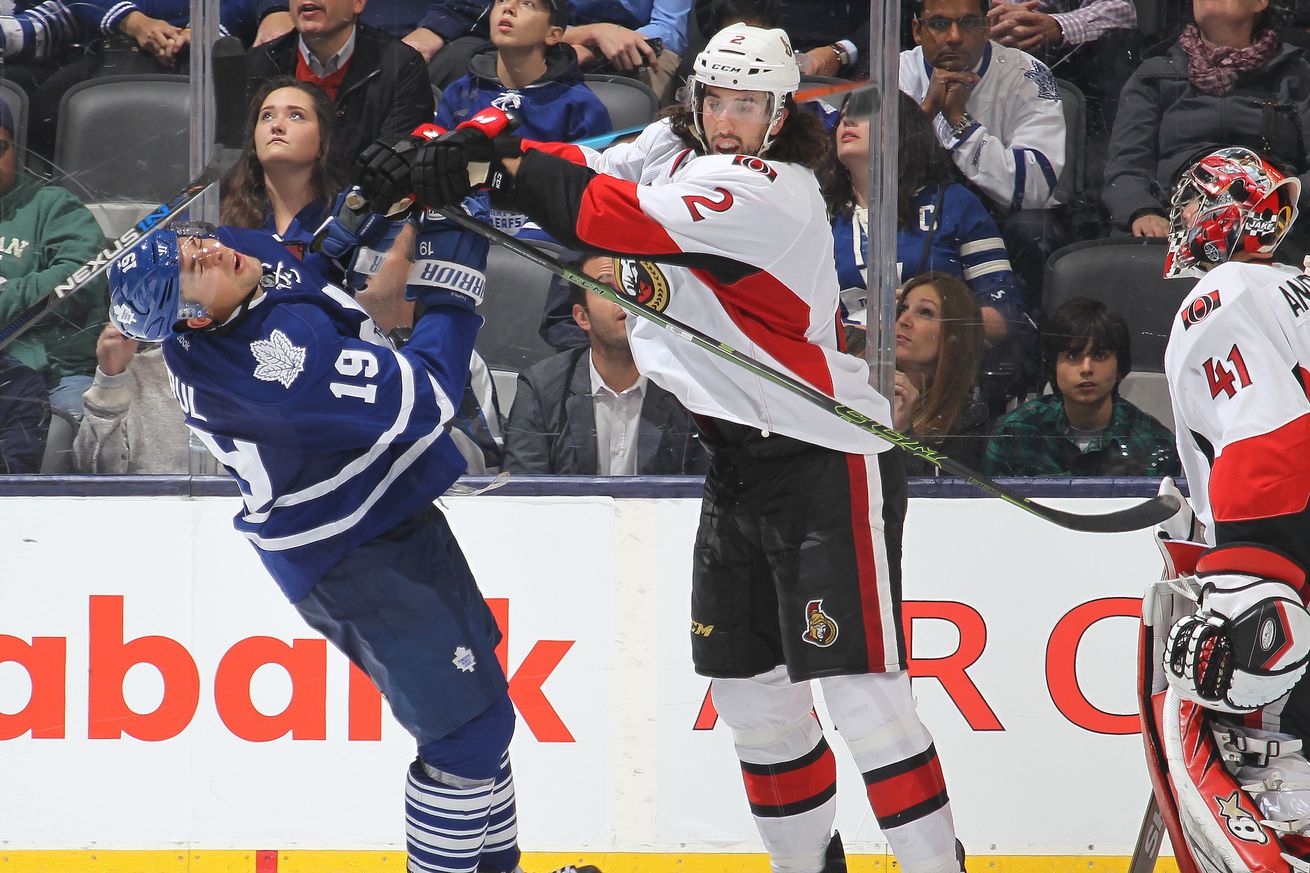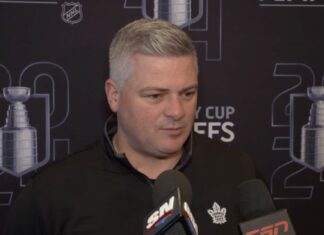The NHL’s 2016 buyout window opens today (June 15) at 5 p.m. EST and runs until the eve of free agency on June 30.
A reminder of how buyouts are calculated, via Cap Friendly:
- Multiply the remaining salary (excluding signing bonuses) by the buyout amount (as determined by age) to obtain the total buyout cost
- Spread the total buyout cost evenly over twice the remaining contract years
- Determine the savings by subtracting the annual buyout cost from Step 2. by the players salary (excluding signing bonuses)
- Determine the remaining caphit by subtracting the savings from Step 3. by the players Annual Average Salary (AAV) (including signing bonuses)
Here is the link to the Cap Friendly buyout-calculator toy and here is a good list of some of the buyout possibilities across the league. Without further ado, let’s take a closer look at the Leafs‘ options.
Jared Cowen
| SEASON | SALARY | INITIAL CAP HIT | ACTUAL COST | SAVINGS | BUYOUT CAP HIT |
|---|---|---|---|---|---|
| 2016-17 | $4,500,000 | $3,100,000 | $750,000 | $3,750,000 | -$650,000 |
| 2017-18 | $0 | $0 | $750,000 | -$750,000 | $750,000 |
Jared Cowen qualifies as an under-26 buyout, meaning the club is on the hook for one-third of the remaining contract value as opposed to two-thirds if he was 26 or over. He’s also on a back-loaded contract wherein the salary is largest in its final year ($4.5 million), putting together the unique circumstances required for a $650,000 salary cap credit in 2016-17. The 2017-18 buy-out cap hit will be $750,000, creating what is essentially a wash (just a $100,000 difference) for the overall buyout.
Before the trade deadline, there were rumblings of the Leafs potentially using Jared Cowen as a trade chip by offering his buyout to a cap-strapped team for whom the $650,000 credit in 2016-17 might actually matter. One rumoured possibility was a deal involving Chicago and the one year remaining of Bryan Bickell’s $4 million AAV contract. The problem with that type of deal from the Leaf perspective is that the organization took on the contracts of Brooks Laich, Colin Greening and Milan Michalek to facilitate trades at the deadline. All told, that adds up to $11.15 million in cap space for 2016-17, and that’s without factoring in Stephane Robidas’ dead money (which can’t be bought out for any savings due to the 35+ rule). The Leafs locked down their only significant RFAs in Morgan Rielly and Nazem Kadri right after the season ended, but they’re running out of space to take on bad contracts if they also want to do any spending in unrestricted free agency.
Leafs brass protected themselves against the risk of an injury, sitting out the chronically-injured Cowen entirely after the trade, in order to ensure he could be bought out. There’s a possibility that Lou Lamoriello gets creative here with a trade, but the odds are that the Leafs will simply buy him out before the window closes on June 30.
Colin Greening
| SEASON | SALARY | INITIAL CAP HIT | ACTUAL COST | SAVINGS | BUYOUT CAP HIT |
|---|---|---|---|---|---|
| 2016-17 | $3,200,000 | $2,650,000 | $1,066,667 | $2,133,333 | $516,667 |
| 2017-18 | $0 | $0 | $1,066,667 | -$1,066,667 | $1,066,667 |
The only case to be made for jettisoning Greening via buyout is to clear out some of the flotsam hanging around the Leaf roster to make space for the anticipated injection of young talent up front. That isn’t likely to be the Leafs’ decision, though.
Many thought Greening was Marlie-bound upon his arrival in Toronto, so it wouldn’t be unexpected if he played out some of his remaining year in the AHL (or bounced between the leagues). Burying $950,000 of Greening’s salary in the AHL takes Greening’s cap hit down to $1.7 million. The Leafs will likely just let him play out the final year of his contract, for better or worse, rather than eat the additional $1.066 million hit in 2017-18.
Greening was a pleasant surprise upon arrival in Toronto after the Phaneuf trade while receiving opportunity he wasn’t going to get in many places around the league. He played 14 and a half minutes a game including 2:30 on the powerplay, and looked good on a line with William Nylander after his callup. His 15 points in 30 games, including seven goals, is as productive as Greening has been since his 17-goal 2011-12 season in Ottawa that got him paid.
As of today, the Leafs don’t have the depth of competition going into 2016 training camp to suggest that Greening couldn’t come in and earn some minutes as a veteran presence on the wing. You wouldn’t bank on it, but the best case scenario is that he makes himself a marketable rental come the deadline. His salary isn’t as prohibitive as the term Bryan Murray originally gave him, and he brings some size to a team without much of it. With the ability to easily retain some salary on an expiring contract at the deadline, Greening might fetch a mid-round pick if everything goes well.
Milan Michalek
| SEASON | SALARY | INITIAL CAP HIT | ACTUAL COST | SAVINGS | BUYOUT CAP HIT |
|---|---|---|---|---|---|
| 2016-17 | $4,000,000 | $4,000,000 | $1,333,333 | $2,666,667 | $1,333,333 |
| 2017-18 | $0 | $0 | $1,333,333 | -$1,333,333 | $1,333,333 |
Michalek played just 13 games for the Leafs before a leg injury finished his season, but he did record five points in his final seven games of the season while getting some time with Nazem Kadri and Michael Grabner at 5v5. Babcock also played him nearly three minutes a game on the powerplay, where he recorded three of those five points. Michalek has slowed down considerably and his skating stride is getting difficult to watch. However, he’s a well-respected veteran of the league who can chip in some offense, and he should get a chance to bring some of that experience to a young roster next season in lieu of other options. Like with Greening, eating a $1.33 million cap hit in 2017-18, rather than just letting him play out the final year of his contract, doesn’t make sense given the Leafs’ current timeline.
Joffrey Lupul
| SEASON | SALARY | INITIAL CAP HIT | ACTUAL COST | SAVINGS | BUYOUT CAP HIT |
|---|---|---|---|---|---|
| 2016-17 | $5,250,000 | $5,250,000 | $1,500,000 | $3,750,000 | $1,500,000 |
| 2017-18 | $3,750,000 | $5,250,000 | $1,500,000 | $2,250,000 | $3,000,000 |
| 2018-19 | $0 | $0 | $1,500,000 | -$1,500,000 | $1,500,000 |
| 2019-20 | $0 | $0 | $1,500,000 | -$1,500,000 | $1,500,000 |
As seen in the chart above (a $3 million hit in 2017-18 is far from palatable), the Maple Leafs are a year away from seriously considering this option with Lupul (here’s his buyout calculation for next June). It may be a moot point anyway considering Lupul would need to pass a physical in order to be bought out and he is still recovering from surgery.
A late season interview with Lupul after his latest significant injury seemed to depict a player with some doubts about the status of his hockey career moving forward. When asked about Lupul’s situation recently, Lou Lamoriello mentioned the seriousness of the surgery Lupul underwent and described the soon-to-be 33 year old as an unknown heading into next season.
Lupul battled some prolonged dry spells and tallied only three assists, but he still managed 11 goals in 46 games this past season, which isn’t terrible considering his usage. Mike Babcock didn’t put him into many scoring situations last season — he was 12th among Leaf forwards in powerplay time-on-ice per game and played with Nick Spaling as his primary centerman at 5v5.
Lupul feels like a pricey afterthought at this stage, but as one of few proven NHL scorers on the roster at the moment, he shouldn’t be written off entirely (and he can’t be through an affordable buyout anyway). As always, it all depends on his health.



![Sheldon Keefe Post Game, Leafs 3 vs. Bruins 2: “I loved [the Matthews] line, and I loved a lot about our game all the way through the lineup” Sheldon Keefe, Toronto Maple Leafs post game](https://mapleleafshotstove.com/wp-content/uploads/2024/04/keefe-pg-game-1-218x150.jpg)


























![Sheldon Keefe Post Game, Leafs 3 vs. Bruins 2: “I loved [the Matthews] line, and I loved a lot about our game all the way through the lineup” Sheldon Keefe, Toronto Maple Leafs post game](https://mapleleafshotstove.com/wp-content/uploads/2024/04/keefe-pg-game-1-100x70.jpg)




![Jim Montgomery on adjustments for Game 2 vs. the Maple Leafs: “We need to spend more time in the offensive zone… We didn’t do a good job offensively at five-on-five [in Game 1]” Jim Montgomery, Boston Bruins practice](https://mapleleafshotstove.com/wp-content/uploads/2024/04/jim-montgomery-bruins-100x70.jpg)